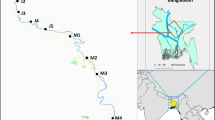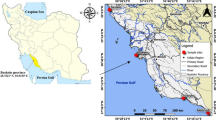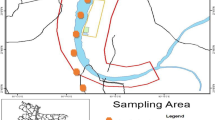Abstract
Heavy metal contamination of fish is a serious public health concern worldwide, including in Bangladesh. In this study, six commonly consumed fish species namely Hilsha (Tenualosa ilisha), Kachki (Corica soborna), Punti (Puntitus ticto), Taki (Channa punctatus), Meni (Nandus nandus), and Tengra (Mystus tengara) were analyzed for arsenic (As), cadmium (Cd), lead (Pb), zinc (Zn), copper (Cu), chromium (Cr), manganese (Mn), and nickel (Ni), by inductively coupled plasma mass spectrometry. The fish samples were collected from wholesale markets in Dhaka city, the main business hub of Bangladesh where the fishes converged from countrywide and are redistributed to the whole city. The metal concentration varied among the studied fish species. Hilsha, the national fish of Bangladesh, contained the highest As among the other fishes of this study, whereas Zn, Cd, Cu, Mn, and Ni were the highest in Kachki, and Pb and Cr were the highest in Tengra. The probable source of metal accumulation in the fish species may be the river or marine water that can be contaminated by industrial waste, pesticide, and/or fertilizer use in agriculture and/or commercial fish feeds. All analyzed fish species showed serious heavy metal pollution, having high average pollution load index (APLI) values (> 1). The estimated daily intake (EDI) values for the metals were lower than the maximum tolerable daily intake (MTDI). The hazard index (HI) for all the fish species was above 1 for adults, showing non-carcinogenic health risks. The target carcinogenic risk (TCR) values were below the acceptable limit (10−4) for most of the metals, indicating safe for consumption with respect to the risk of cancer.




Similar content being viewed by others
Data Availability
The data underlying of this research will be shared on reasonable request to the corresponding author.
References
Chakraborty TK, Chandra Ghosh G, Hossain MR, Islam MS, Habib A, Zaman S, Bosu H, Nice MS, Haldar M, Khan AS (2022) Human health risk and receptor model-oriented sources of heavy metal pollution in commonly consume vegetable and fish species of high Ganges river floodplain agro-ecological area, Bangladesh. Heliyon 8(10):e11172. https://doi.org/10.1016/j.heliyon.2022.e11172
Islam MS, Islam MT, Antu UB, Saikat MSM, Ismail Z, Shahid S, Islam ARMT, Ali MM, Al Bakky A, Ahmed S, Ibrahim KA, Al-Qthanin RN, Idris AM (2023) Contamination and ecological risk assessment of Cr, As, Cd and Pb in water and sediment of the southeastern Bay of Bengal coast in a developing country. Mar Pollut Bull 197:115720. https://doi.org/10.1016/j.marpolbul.2023.115720
Ali MM, Ali ML, Bhuyan MS, Islam MS, Rahman MZ, Alam MW, Das M, Mustary S, Islam MN (2022) Spatiotemporal variation and toxicity of trace metals in commercially important fish of the tidal Pasur River in Bangladesh. Environ Sci Pollut Res 29(26):40131–40145. https://doi.org/10.1007/s11356-022-18821-y
Al-Rmalli SW, Jenkins RO, Watts MJ, Haris PI (2021) Determination of arsenic, cadmium, selenium, zinc and other trace elements in Bangladeshi fish and arsenic speciation study of Hilsa fish flesh and eggs: implications for dietary intake. Biomed Spectroscop Imaging 10(1-2):9–26. https://doi.org/10.3233/BSI-210212
Parvin A, Hossain MK, Shahjadee UF, Lisa SA, Uddin MN, Shaikh MAA, Parvin A, Moniruzzaman M, Saha B, Suchi PD (2023) Trace metal exposure and human health consequences through consumption of market-available Oreochromis niloticus (L.) in Bangladesh. Environ Sci Pollut Res 30(15):45398–45413. https://doi.org/10.1007/s11356-023-25414-w
Mitra S, Chakraborty AJ, Tareq AM, Emran TB, Nainu F, Khusro A, Idris AM, Khandaker MU, Osman H, Alhumaydhi FA, Simal-Gandara J (2022) Impact of heavy metals on the environment and human health: novel therapeutic insights to counter the toxicity. J King Saud Univ -Sci 34(3):101865. https://doi.org/10.1016/j.jksus.2022.101865
HIES (2022) Preliminary report on household income and expenditure survey 2022. Bangladesh Bureau of Statistics, Statistics and Informatics Division, Ministry of Planning, Dhaka
Ali MM, Ali ML, Jahan Rakib MR, Islam MS, Bhuyan MS, Senapathi V, Chung SY, Roy PD, Sekar S, Md Towfiqul Islam AR, Rahman MZ (2022) Seasonal behavior and accumulation of some toxic metals in commercial fishes from Kirtankhola tidal river of Bangladesh—a health risk taxation. Chemosphere 301:134660. https://doi.org/10.1016/j.chemosphere.2022.134660
Hossain MB, Tanjin F, Rahman MS, Yu J, Akhter S, Noman MA, Sun J (2022) Metals bioaccumulation in 15 commonly consumed fishes from the lower Meghna river and adjacent areas of Bangladesh and associated human health hazards. Toxics 10(3):139. https://doi.org/10.3390/toxics10030139
Wahiduzzaman M, Islam MM, Sikder AHF, Parveen Z (2022) Bioaccumulation and heavy metal contamination in fish species of the Dhaleswari river of Bangladesh and related human health implications. Biol Trace Elem Res 200(8):3854–3866. https://doi.org/10.1007/s12011-021-02963-0
Lipy EP, Hakim M, Mohanta LC, Islam D, Lyzu C, Roy DC, Jahan I, Akhter S, Raknuzzaman M, Abu Sayed M (2021) Assessment of heavy metal concentration in water, sediment and common fish species of Dhaleshwari river in Bangladesh and their health implications. Biol Trace Elem Res 199(11):4295–4307. https://doi.org/10.1007/s12011-020-02552-7
Ali MM, Ali ML, Proshad R, Islam S, Rahman Z, Tusher TR, Kormoker T, Al MA (2020) Heavy metal concentrations in commercially valuable fishes with health hazard inference from Karnaphuli river, Bangladesh. Hum Ecol Risk Assess Int J 26(10):2646–2662. https://doi.org/10.1080/10807039.2019.1676635
Hossain MN, Rahaman A, Hasan MJ, Uddin MM, Khatun N, Shamsuddin SM (2021) Comparative seasonal assessment of pollution and health risks associated with heavy metals in water, sediment and fish of Buriganga and Turag river in Dhaka city. Bangladesh SN Appl Sci 3(4):509. https://doi.org/10.1007/s42452-021-04464-0
Nargis A, Harun-Or-Rashid N, Khanam Jhumur A, Haque ME, Islam MN, Habib A, Cai M (2020) Human health risk assessment of toxic elements in fish species collected from the river Buriganga, Bangladesh. Hum Ecol Risk Assess Int J 26(1):120–146. https://doi.org/10.1080/10807039.2018.1496397
Habib MR, Hoque MM, Kabir J, Akhter S, Rahman MS, Moore J, Jolly YN (2022) A comparative study of heavy metal exposure risk from the consumption of some common species of cultured and captured fishes of Bangladesh. J Food Compos Anal 108:104455. https://doi.org/10.1016/j.jfca.2022.104455
Shorna S, Shawkat S, Hossain A, Quraishi SB, Ullah AKMA, Hosen MM, Hossain MK, Saha B, Paul B, Habibullah-Al-Mamun M (2021) Accumulation of trace metals in indigenous fish species from the old Brahmaputra river in Bangladesh and human health risk implications. Biol Trace Elem Res 199(9):3478–3488. https://doi.org/10.1007/s12011-020-02450-y
Hasan GMMA, Satter MA, Das AK, Asif M (2022) Detection of heavy metals in fish muscles of selected local fish varieties of the Shitalakshya river and probabilistic health risk assessment. Measurement: Food 8:100065. https://doi.org/10.1016/j.meafoo.2022.100065
Sarker MJ, Polash AU, Islam MA, Rima NN, Farhana T (2020) Heavy metals concentration in native edible fish at upper Meghna river and its associated tributaries in Bangladesh: a prospective human health concern. SN Appl Sci 2(10):1667. https://doi.org/10.1007/s42452-020-03445-z
Palash MAU, Islam MS, Bayero AS, Taqui SN, Koki IB (2020) Evaluation of trace metals concentration and human health implication by indigenous edible fish species consumption from Meghna river in Bangladesh. Environ Toxicol Pharmacol 80:103440. https://doi.org/10.1016/j.etap.2020.103440
Tahity T, Islam MRU, Bhuiyan NZ, Choudhury TR, Yu J, Noman MA, Hosen MM, Quraishi SB, Paray BA, Arai T, Hossain MB (2022) Heavy metals accumulation in tissues of wild and farmed Barramundi from the Northern Bay of Bengal Coast, and its estimated human health risks. Toxics 10(8):410. https://doi.org/10.3390/toxics10080410
Ahmed MK, Shaheen N, Islam MS, Habibullah-al-Mamun M, Islam S, Mohiduzzaman M, Bhattacharjee L (2015) Dietary intake of trace elements from highly consumed cultured fish (Labeo rohita, Pangasius pangasius and Oreochromis mossambicus) and human health risk implications in Bangladesh. Chemosphere 128:284–292. https://doi.org/10.1016/j.chemosphere.2015.02.016
Resma NS, Meaze AKMMH, Hossain S, Khandaker MU, Kamal M, Deb N (2020) The presence of toxic metals in popular farmed fish species and estimation of health risks through their consumption. Physics Open 5:100052. https://doi.org/10.1016/j.physo.2020.100052
Hossain M (2020) Heavy metal contamination in tilapia, Oreochromis niloticus collected from different fish markets of Mymensingh district. J Agric Food Environ 1(4):1–5. https://doi.org/10.47440/JAFE.2020.1401
Zakir HM, Quadir QF, Mollah MZI (2021) Human health risk assessment of heavy metals through the consumption of common foodstuffs collected from two divisional cities of Bangladesh. Expo Health 13(2):253–268. https://doi.org/10.1007/s12403-020-00380-7
Biswas KP, Hossain S, Deb N, Bhuian AKMSI, Gonçalves SC, Hossain S, Hossen MB (2021) Assessment of the levels of pollution and of their risks by radioactivity and trace metals on marine edible fish and crustaceans at the Bay of Bengal (Chattogram, Bangladesh). Environments 8(2):13. https://doi.org/10.3390/environments8020013
BBS (2022) Population and Housing Census 2022 Preliminary Report. Bangladesh Bureau of Statistics, Statistics and Informatics Division, Ministry of Planning, Dhaka
Hossain MA, Huggins R (2021) The environmental and social impacts of unplanned and rapid industrialization in Suburban areas: the case of the greater Dhaka region. Bangladesh Environ Urban ASIA 12(1):73–89. https://doi.org/10.1177/0975425321990319
Minten B, Murshid KAS, Reardon T (2013) Food quality changes and implications: evidence from the rice value chain of Bangladesh. World Dev 42:100–113. https://doi.org/10.1016/j.worlddev.2012.06.015
Liu F, Li M, Lu J, Lai Z, Tong Y, Wang M (2021) Trace Metals (As, Cd, Cr, Cu, Hg, Ni, Pb, Zn) and stable isotope ratios (δ13C and δ15N) in fish from Wulungu Lake, Xinjiang, China. Int J Environ Res Public Health 18(17):9007. https://doi.org/10.3390/ijerph18179007
FAO/WHO (2002) Joint FAO/WHO Food Standards Programme Codex Committee on contaminants in foods. Thirty-fourth Session. CX/FAC 02/16. Codex Alimentarius Commission, Rotterdam
FAO/WHO (2022) Joint FAO/WHO Food Standards Programme Codex Committee on Contaminants in Foods. 15th Session. Food CF/15 INF/01. Codex Alimentarius Commission, The Hague.
FAO/WHO (1989) Evaluation of certain food additives and the contaminants mercury, lead and cadmium. In: WHO Technical report Series No. 505. World Health Organization, Geneva
USEPA (2023) Regional screening levels (RSLs)—generic tables. In: Summary table 404057. US Environmental Protection Agency, Washington, DC
Kormoker T, Proshad R, Islam MS, Shamsuzzoha M, Akter A, Tusher TR (2021) Concentrations, source apportionment and potential health risk of toxic metals in foodstuffs of Bangladesh. Toxin Rev 40(4):1447–1460. https://doi.org/10.1080/15569543.2020.1731551
USEPA (2016) Risk-based concentration table. In: Summary Table. US Environmental Protection Agency, Washington, DC
Ahmad SA, Khan MH, Haque M (2018) Arsenic contamination in groundwater in Bangladesh: implications and challenges for healthcare policy. Risk Manag Healthcare Policy 1:251–261. https://doi.org/10.2147/RMHP.S153188
Rakib MRJ, Jolly YN, Enyoh CE, Khandaker MU, Hossain MB, Akther S, Alsubaie A, Almalki ASA, Bradley DA (2021) Levels and health risk assessment of heavy metals in dried fish consumed in Bangladesh. Sci Rep 11(1):14642. https://doi.org/10.1038/s41598-021-93989-w
JECFA (1989) Evaluation of certain food additives and contaminants. Thirty-third report of Joint FAO/WHO Expert Committee on Food Additives. In: WHO Technical Report Series, No. 776. World Health Organization, Geneva
JECFA (2011) Evaluation of certain food additives and contaminants. Seventy-third report of the Joint FAO/WHO Expert Committee on Food Additives. In: WHO Technical Report Series, No. 960. World Health Organization, Geneva
JECFA (2000) Evaluation of certain food additives and contaminants. Fifty-third report of Joint FAO/WHO Expert Committee on Food Additives. In: WHO Technical Report Series, No. 896. World Health Organization, Geneva
WHO (1996) Guidelines for drinking-water quality. World Health Organization, Geneva
JECFA (1971) Evaluation of food additives. Fourteenth report of the Joint FAO/WHO Expert Committee on Food Additives. In: WHO Technical Report Series, No. 462. World Health Organization, Geneva
RDA (1989) Recommended dietary allowances, 10th edn. National Academy Press, Washington, DC
Acknowledgements
The authors acknowledge the support of Environmental Laboratory, Yokohama National University, Japan, for providing laboratory facilities for the analysis of metals.
Author information
Authors and Affiliations
Contributions
N.S.: conceptualization, methodology, investigation, resources, supervision, writing—review and editing. M.S.: methodology, formal analysis, software, writing—original draft. T.H.: methodology, formal analysis, software, writing—original draft. I.N.K.: visualization, data curation, writing—original draft. N.M.I.: visualization, data curation, writing—original draft. M.K.A.: investigation, resources, writing—review and editing.
Corresponding author
Ethics declarations
Conflict of Interest
The authors declare no competing interests.
Additional information
Publisher’s Note
Springer Nature remains neutral with regard to jurisdictional claims in published maps and institutional affiliations.
Supplementary Information
ESM 1
(DOCX 15 kb)
Rights and permissions
Springer Nature or its licensor (e.g. a society or other partner) holds exclusive rights to this article under a publishing agreement with the author(s) or other rightsholder(s); author self-archiving of the accepted manuscript version of this article is solely governed by the terms of such publishing agreement and applicable law.
About this article
Cite this article
Shaheen, N., Sultana, M., Hasan, T. et al. Heavy Metals in Common Fishes Consumed in Dhaka, a Megacity of Asia: A Probabilistic Carcinogenic and Non-Carcinogenic Health Hazard. Biol Trace Elem Res (2024). https://doi.org/10.1007/s12011-024-04140-5
Received:
Accepted:
Published:
DOI: https://doi.org/10.1007/s12011-024-04140-5




